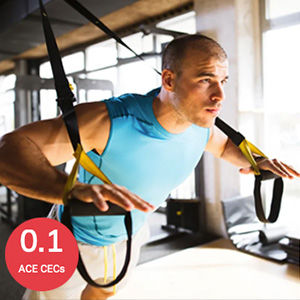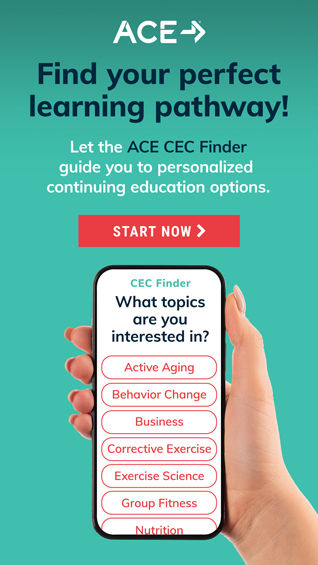
In this series, ACE experts answer your health and exercise questions. From nutrition to youth fitness, you’ll find detailed answers to many of the questions that may come up in your work with clients. If you have questions you’d like to ask our experts, please email us at Christine.Ekeroth@acefitness.org.

The Expert: Lance C. Dalleck, PhD, is a professor of Exercise and Sport Science at Western Colorado University. His research interests include improving exercise performance and health outcomes through evidence-based practice, quantifying the energy expenditure of outdoor and non-traditional types of physical activity, and studying historical perspectives in health, fitness and exercise physiology. Dr. Dalleck is a member of the ACE Scientific Advisory Panel.
Q: I keep reading about “evidence-based practice,” but I’m not entirely sure what it means. And what does it have to do with being a health coach or personal trainer?
A: This is a great question. Sometimes experts in the industry use these terms or phrases without taking the time to really explain what they mean. Let’s take a closer look at evidence-based practice and how you can apply this information to your work as a health and exercise professional.
When you design personalized exercise programs for your clients, it is essential that you base that programming on a combination of three factors:
- Client attributes and preferences
- Your experience and expertise
- The latest research findings in health and fitness
This multifaceted approach to personalized exercise programming is known as evidence-based practice (Figure 1). Evidence-based practice is a client-centered approach that guides the design, implementation, supervision and evaluation of effective workout programs. By integrating research with practical experience and client needs, you can make informed decisions that enhance both safety and results. Developing and applying this skill not only improves outcomes for current clients but also strengthens your ability to adapt and innovate for future clients

Figure 1. An exercise program built on a foundation of evidence-based practice (EBP) equally considers the client, the exercise professional’s expertise and experience, and research findings in health and fitness.
In a client-centered approach to personal training, the first series of interactions between you and your client are typically focused on learning more about your client. For instance, you likely gather personal attribute-related data about your clients, including age, health history, chronic-disease status and exercise training goals. You may also perform baseline assessments that offer important preliminary information about the client. You’ll also spend time identifying your client’s preferences toward physical activity, including factors such as exercise equipment/program likes and dislikes, weekly availability for training and potential barriers to regular physical activity. This type of evaluation is a vital preliminary step in evidence-based practice.
Once the initial evaluation is complete, there are five steps that comprise the formal process of evidence-based practice (Figure 2):
- Developing a question
- Searching for health and fitness research evidence that best answers the formulated question
- Scrutinizing the quality of research evidence
- Incorporating the research evidence into your exerciseprogram design and implementation
- Evaluating exercise program outcomes and periodically reevaluating the research evidence

Figure 2. The five-step process of evidence-based practice
Now that you know a bit more about what evidence-based practice is, we can look more closely at how you can integrate it into your program design.
At the core of human physiology are underlying mechanisms that drive all bodily functions. The role of science in health and fitness is to uncover these mechanisms and apply them to practice. However, the fitness industry is often clouded by misinformation, bias and persistent myths that continue to influence both trainers and clients. Misconceptions about lactic acid, the “fat-burning zone” and spot reduction are just a few examples that fail under scientific scrutiny. As a health and exercise professional who embraces evidence-based practice, you can help dispel these myths and ensure that clients receive accurate information and effective training strategies. Staying up to date with current research enables you to design safe, efficient programs that support long-term success and optimal results.
Make AI Your Research Assistant
Artificial intelligence (AI) can also be a valuable tool for locating and understanding scientific research. AI-powered search engines and databases, such as Google Scholar, PubMed and Semantic Scholar, can help you quickly find relevant studies on specific topics. AI-driven summarization tools can break down complex research papers into key findings, making them easier to digest. Additionally, some AI applications can track new publications in your areas of interest, ensuring that you stay up to date without spending hours searching for new studies. By leveraging AI responsibly, personal trainers can streamline the research process and make informed, science-backed decisions more efficiently.
Integrating evidence-based practice into program design starts with critically evaluating research and applying findings in a way that aligns with each client’s unique needs, goals and abilities. This involves selecting exercises with proven effectiveness, utilizing progressive overload principles and ensuring that training intensity, volume and recovery align with best practices. Additionally, maintaining an open dialogue with your clients, tracking their progress using objective data and adapting programs based on real-world results will further enhance the effectiveness of your approach. By combining scientific knowledge with practical experience, you can create well-rounded, results-driven programs that maximize client success while minimizing the risk of injury or ineffective training methods.
Implementing evidence-based practice requires a consistent investment of time and effort, as outlined in Figure 2. However, this process does not need to feel overwhelming or interfere with the natural flow of your interactions with clients. In fact, integrating evidence-based strategies into training sessions enhances the overall experience, leading to safer, more effective programming and improved client outcomes. When applied thoughtfully, evidence-based practice strengthens the trainer’s ability to make informed decisions while maintaining a dynamic and engaging training environment.
The following recommendations outline practical strategies to seamlessly and successfully integrate evidence-based practice into your sessions with clients.
- After the initial client-trainer consultation, take the time to develop a few questions that coincide with your client’s goals:
- What are the benefits of cardiorespiratory exercise if my client is taking an anti-obesity medication and losing weight?
- Is high-intensity resistance training a safe and effective option for my client given her limited time availability?
- Be sure to allocate a realistic amount of time to spend searching and evaluating scientific evidence.
- Remember that not all sources of evidence are equal. Levels of evidence range from least robust/most biased to most robust/least biased.
- Robust evidence-based practice is equally dependent on your expertise and experience. After considering the unique aspects of a given client, coupled with the relevant health and fitness research evidence, it is up to you to create a safe and effective exercise program.
- Be sure to regularly evaluate how well evidence-based, personalized exercise programs are functioning. Are target goals being achieved? Does the client enjoy the program? Is there good adherence to training sessions?
- Periodically, it is important to reexamine the scientific literature for each given health and fitness topic in order to stay current with advances in research.
Q: With so much information out there, coming from so many different sources, staying updated on current research feels really overwhelming. Do you have any tips or strategies for how I can accomplish this with my busy schedule?
A: As a professional in a science-based field, you must carefully choose which information you will utilize when making decisions about training your clients. In addition to knowing how research studies are conducted, you should be aware of factors that either support or detract from reported evidence. Here are four tips that can help you recognize evidence-based science:
1. Look for bias on the part of the investigator. Does the investigator have anything to gain by promoting this point of view or product?
2. If research is cited, review the full research paper to get an idea of the sample size, the methodology, conclusions and limitations, validity (how accurately does the research measure what it set out to measure) and reliability (how consistent are the results). This information will shed light on potential logical fallacies. If no research is cited, the claim is likely not an example of evidence-based science.
3. Determine if there are any logical fallacies committed by investigator. Examples can include overstating and overgeneralizing research results, misinterpreting correlations, relying on anecdotal experience and selective reporting.
4. Search for scientific consensus on the topic. Position statements from respected organizations (e.g., the American Heart Association) are often accessible for no cost, especially regarding issues that significantly impact public health.
General scientific consensus and research reviews can also help you determine the merit of research claims. When scientists in a particular field of study share a collective opinion or judgment, a scientific consensus exists. The consensus may be based on repeated research, peer review or communication at scientific conferences. To find consensus, look for position statements issued by scientific institutes that communicate a summary of the science for people outside of the scientific community. For example, the article, AHA Scientific Statement: Supervision of Exercise Testing by Nonphysicians: A Scientific Statement from the American Heart Association, is a position paper offered to health and fitness professionals that summarizes the American Heart Association’s consensus on the topic. If an individual such as an influencer espouses views that strongly contradicts the current scientific consensus on a subject, it is likely that their views are not backed by high-quality scientific evidence.
Sifting through the available scientific research on a given topic and then reading the most relevant papers about that topic is the best approach to understanding the weight of the evidence. However, as a busy health and exercise professional, it is unlikely that you have the time to read large volumes of research, even if you do have access to full papers. In these instances, a good amount of knowledge can still be obtained by reading reviews written by scientists in the field. When researchers write a scientific paper, they perform a literature review, which consists of examining the existing published literature on a subject and then writing a summary of their findings. The literature review is an important part of every research paper, as it lays the foundation for what is already known about the topic.
A literature review should not be confused with a type of study called a systematic review, which provides an exhaustive summary of current literature relevant to a particular topic. A systematic review uses a complex process to study the studies published on a topic. In evidence-based practices, such as medicine and exercise, systematic reviews of high-quality research studies are crucial to the development of recommendations and guidelines for the field. As such, if a systematic review can be found on a specific subject, it would be a good place to start when looking for persuasive, high-quality evidence.
Staying informed in a constantly evolving field like health and fitness may seem overwhelming, but by developing a strategic approach to evaluating research, you can make evidence-based decision-making a seamless part of your practice. Prioritizing sources that offer systematic reviews, position statements and research summaries from reputable organizations makes it possible for you to stay current without having to sift through every individual study. Additionally, dedicating even a small amount of time each week to reading credible industry publications or subscribing to research-focused newsletters can help you stay ahead of misinformation. Ultimately, embracing an evidence-based mindset not only enhances your credibility as a professional but also ensures that your clients receive the safest, most effective training strategies rooted in sound scientific principles.
Expand Your Knowledge
Value or Hype? Effectiveness of Fitness Products, Programs and Trends According to ACE-sponsored Research
We’re confronted with advertising on a daily basis, especially when it comes to health and fitness. How can you tell if a certain product, program or trend measures up to its marketing claims? This course dives into key ACE-sponsored studies on HIIT training, suspension training, hot yoga, the “best” exercises for various body parts and more. Created by ACE Chief Science Officer Cedric X. Bryant, PhD, FACSM and presented by ACE Director of Science and Research Content Sabrena Jo, MS, this course will teach you how to make more informed decisions regarding these heavily marketed and often hyped products, programs and training trends so you can provide your clients unbiased, evidence-based information.
Strategies for Enhancing Program Design – Course Bundle
When designing an exercise program for clients, there are many ways to create safe and effective training plans. The Strategies for Enhancing Program Design course bundle will elevate your exercise programs by showing you how to integrate agility training, HIIT and the ACE Integrated Fitness® (ACE IFT®) Model. Courses include:
- Mind Body Agility Training (0.1 CECs)
- Programming the Ultimate HIIT Workout (0.1 CECs)
- Progressing Clients From Function to Performance (0.1 CECs)





 by
by 







